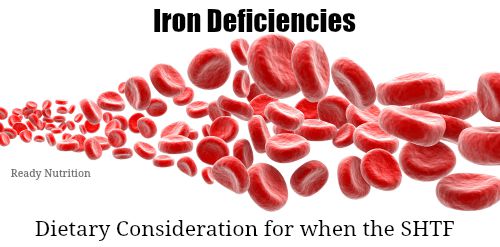Ready Nutrition Readers, put on your helmets and get set for some information that can help you when you consider what you add to your stores and supply lists. We’re going to describe exactly what the importance of iron in your diet is, especially in an apocalyptic setting when food becomes scarce and quality food even scarcer. The information presented in this article covers iron deficiencies and their causes, as well as suggesting some methods to help. The information does not, nor does it intend to diagnose, treat, or prescribe medication. The article is for informational purposes only. Consult with your licensed, certified, trained family physician should you have any of the conditions outlined herein.
We will first cover some terms and definitions essential to understanding iron deficiency. What is iron? Iron is a metallic element found in nature that is essential for the formation of chlorophyll in plants (although not part of the chlorophyll) and part of molecules of hemoglobin and myoglobin in humans and animals. Hemoglobin is what transports oxygen in the blood, and the “heme” portion contains iron that is the binding carrier.
Iron’s Purpose in the Body
Iron is stored in tissues of the body in the spleen, liver, and marrow in the form of ferritin. The intake valve for this supply is the stomach; it breaks down food and sends the ferritin to the marrow, the complex responsible for the manufacture of…you guessed it…red blood cells. We are not going to cover conversion of ferritin to heme and hemoglobin through hematopoeisis…it is beyond the scope of what you need in the immediacy. We have outlined the basic structural mechanisms of how your human machinery processes and uses/converts iron.
Heme or non-heme? That is the question! Heme is one of two types of dietary iron (approx. 10%) obtained in your diet from the hemoglobin and myoglobin of meat, and it is readily absorbed. The other 90% of iron (non-heme) is in iron salt form and not readily absorbed. Daily requirements for iron differ widely by gender and by age/stage of life. Men require 0.5 – 1.0 mg per day, women of menstrual age twice this amount, and pregnant/lactating women need 2-4 mg per day.
The reader may wonder why (with such apparently low amounts of iron required) so much more is recommended for consumption. Such is because only a small percentage of iron consumed in the diet is taken in. To absorb and utilize 1 to 4 mg of iron per day, approximately 15 to 30 mg must be taken in through the diet. You are probably beginning to see how protein intake is critical to supply iron to your system. In a grid-down, end-of-the-world scenario, good stores of protein and iron-bearing compounds are going to be critical for you and your family’s long-term health.
Symptoms of Iron Deficiency
The deficiencies of iron are characterized by anemia, sluggishness, fatigue, and breathlessness on exertion, pallor (paleness), decreased hemoglobin count, and mental fatigue/lack of concentration. Causes are too numerous to count; however we can list a few things that are more directly controllable by you: over-consumption of alcoholic beverages, prescription/non-prescription drug use and/or overuse, increased workload (usually coupled with insufficient rest/recovery), stress/anxiety, and lastly, inadequate uptake of iron in your diet. Some of these items are very important to keep in mind: in a collapse or an emergency, factors such as stress, anxiety, and increased physical workloads will be the norm rather than the exception.
Dietary Changes Can Make All the Difference
We will concern ourselves primarily with this last factor (the diet), because it is here that people can most readily make corrections each day. As the old adage runs, “An ounce of prevention is worth a pound of cure.” Food is your main source of iron, and here is a list (non-exhaustive) of good sources of iron:
meat/fish/poultry almonds asparagus cauliflower soybeans
beets greens* peanuts oatmeal whole wheat
*(Note: ‘greens’ is as it sounds: dark-green vegetables packed with chlorophyll)
Should your symptoms that were outlined a few paragraphs before become pronounced and long-lasting, schedule a test and examination with your physician. He may prescribe an injection of iron dextran (a preparation administered parenterally/not orally) if needed, or a more precise dietary change for you. Keep in mind: you need accuracy; depending on your medical condition and any medications you already take under a doctor’s orders. Sometimes a higher (and unmonitored) uptake of iron can interfere with the treatment you are already receiving. When in doubt, have your doctor check it out.
Lastly, in addition to standard sources for iron, there are some sources that you may never have even considered, and they are as follows: Burdock seeds, Dandelion, Horseradish, Milkweed, Mustard leaves, Pokeweed, Rose Hips, Shepherd’s Purse, Skunk Cabbage, Sorrel, Watercress.
Such resources could be utilized in the events of a survival situation (a remote wilderness area, for example), or if income limits your choices in the happy, wonderful, pre-packaged supermarkets. I wrote an article a few months back that covered an excellent book entitled “Eat the Weeds,” by Ben Charles Harris, written in 1973.
The book is packed with scientific data that has not changed. What has changed is the climate that information is presented within today. A source should never be discredited due to age; the information it presents can always be cross-checked and verified. An “old” source such as this presents information that does not run “on the same path as the herd,” so to speak. If it cannot be commercialized, mass-produced, and sold in Wal-Mart, information such as this is usually relegated to the “back burner” and either discounted or ignored. Remember: You are your own best researcher.
To summarize, iron deficiencies can be prevented, both in a normal environment such as today and when the SHTF. You can take all of the guesswork about it by laying in the proper supplies beforehand, such as iron supplements and protein stores. Hope you enjoyed this information, and have a great day!
JJ

